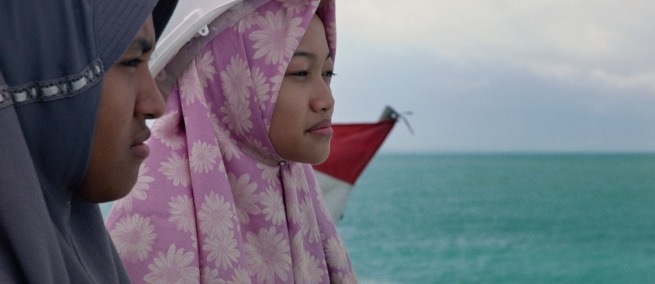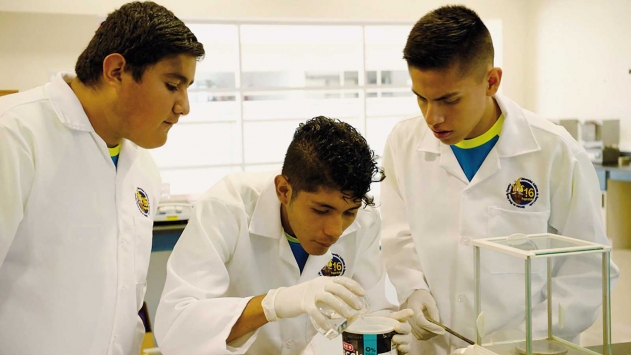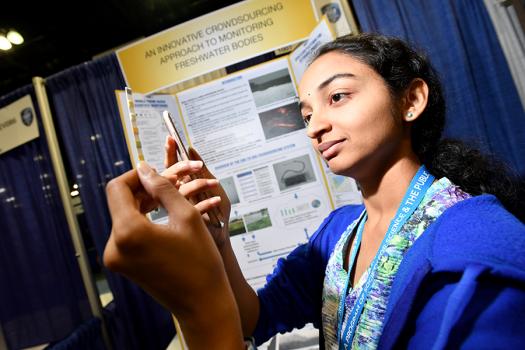
Environmental issues caused by climate change, industrial contamination, and toxic waste are some of the pressing global problems that face the world. Six high school students from Indonesia, Mexico, Hawaii, and India have conceived of different solutions to environmental issues in their respective countries, and are the subject of Laura Nix’s new documentary INVENTING TOMORROW. The students travel to the Intel International Science and Engineering Fair–the world’s largest high school science competition. INVENTING TOMORROW follows their journey to Los Angeles to compete and then home again.
INVENTING TOMORROW made its world premiere at the 2018 Sundance Film Festival. It was also part of the science program at CPH: DOX in Copenhagen, where Science & Film sat down with Laura Nix.
Science & Film: How did you find out about the Intel Science Fair?
Laura Nix: My producers brought the idea for the film to me. I didn’t know anything about it. I started researching the fair, and immediately fell in love with the kids. At the same time, I did not want to make a film that was in the competition genre. There are many documentaries that have been made about competitions, especially youth competitions, and I didn’t want to make that film. I said that I’d be more interested in making a film that focused on environmental impact because, when I met the kids, those were the stories that had the most impact on me.
A lot of those competition filmmakers just show up at the fair, see who wins, then go home with them and reverse it to look like it’s been filmed before. That’s why they end up with the winners. We didn’t do that. I was following the kids not because I thought they would win but because I believed in what they were doing.
S&F: Isn’t there another film, SCIENCE FAIR, about the same fair?
LN: I haven’t seen it. My understanding is it’s very much based on that competition genre and focused on that structure, and that’s one approach.
S&F: You said you were interested primarily in people whose projects were addressing environmental issues, is that right? Is there a reason you made that choice, aside from the fact that it’s the most important issue of our time?
LN: I went to the fair in 2016 and did some filming, and I met a number of kids who were working on issues related to the environment. I was compelled by what they were doing and the potential impact their projects could have. For example, I met these girls from Egypt where there is the threat of great water shortage; a lot the country’s drinking water comes from desalination plants, but desalination is incredibly energy inefficient, so the girls were trying to come up with an energy efficient model of desalination which could be a game changer.

S&F: Were you daunted by the scientific content of their projects?
LN: I don’t come from a scientific background but in some ways that’s helpful because it means I’m a proxy for the audience. So I was probably really annoying for the kids because I asked so many questions. I couldn’t let them rely on jargon. I think that’s a part of science communication which is another theme of the film–the importance of establishing a bridge and a dialogue between what scientists are doing and the general public.
The truth is that being a practitioner of the scientific method involves a lot of failure. I think that also mirrors life and that’s something you have to learn as you get older, that failure is part of the process.
S&F: There are some students you follow who are very advanced students, and some who are less so. Was that range important to you?
LN: I wanted that range. I wanted to show that this is a process. Each kid is taking on a project and they have to find their own way and work super hard. Some put up to 600 hours into their project before they end up at the fair. The process is so much about effort. I think that’s a true thing for many endeavors in life; you just have to keep at it.
S&F: How have high school students responded to the film so far?
LN: Those are the best screenings ever. We did ten screenings at Sundance and it was an amazing experience. People had a very emotional response to the film which was exciting because I wanted that. You hope it’s going to work for an audience in that way but I wasn’t sure. We did a screening in Park City for 600 high school students and they went totally bananas. They gave a standing ovation, they were cheering. Then the kids from the film came on stage, because we brought our whole cast to Sundance, and the crowd went totally nuts; they rushed the stage after the Q&A to get their autographs and pictures. The cast were like rock stars. I like that response, because one of my hopes was that students would be inspired because they see a parallel between their lives and the lives of the kids on screen. If it ends up encouraging kids to think science is an option, if it ends up encouraging kids just to work hard, and that working hard is cool, that’s great.

S&F: Who do you want to see this film?
LN: We have a lot of goals in terms of making such we get as many young people to see the film as possible. Educators, advocates for STEM education, etc. The response to the film has been that people really want other young people to see the film. STEM education is under attack right now in many parts of the country. We’re in this moment of total science denial and I’ve experienced that people are sometimes more apt to listen to what is happening if it comes from a child than if it comes from an adult. They believe the adult has been coopted somehow and that the child hasn’t. Which is right, that’s true, I’m not saying that the older scientists have been coopted, but the kids are telling it like it is.
S&F: So do you think people who are say science deniers would watch this film and that could affect how they see things?
LN: [shrugs]
S&F: Who knows, yeah. Fingers crossed.
LN: [laughs]
INVENTING TOMORROW is directed by Laura Nix. It is produced by Nix, Diane Becker, and Melanie Miller. The film will continue to play at festivals around the world in the coming months. In June, it will be at the Seattle International Film Festival, the Mendocino Film Festival, and at AFI DOCS.
TOPICS